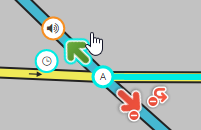Streets meeting at less than 46 degrees

If drivers reaching a junction tend to slow and/or stop at an angle less than 46° to the cross road, but a turn left or right instruction is still warranted, a TIO may be used to force a turn instruction. Angles greater than 46° will issue turn instructions automatically and should not be overridden.
Before Waze introduced override capability, editors forced turn instructions at such intersections by adding "dogleg" geometry nodes to ensure junction angles between 46° and 170° exclusive. When concerned about display, editors added doglegs at such fine scale as to be nearly invisible; these are called "micro-doglegs". Doglegs and micro-doglegs continue to work properly and there is no present need to replace them with overrides.
Note that doglegs remain a correct and useful technique. They are completely appropriate when they reflect the typical path of drivers as they slow and stop for a turn. Even if drivers tend to approach at very sharp angles, doglegs may be used to widen the junction angle to at least 20° whether or not a TIO is used. This makes it easier for drivers to identify the turn for closure via the app, as well as for editors to select the segment when using limited mobile tools (typically to drop or raise locks by request).
Other pre-override instruction-forcing methods, especially short "segment to nowhere" stubs and deliberately incorrect alternate names, are no longer appropriate. They continue to work, however, and should be updated with care.